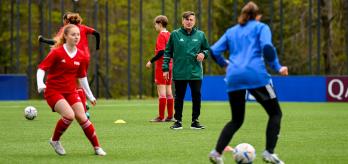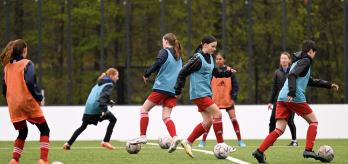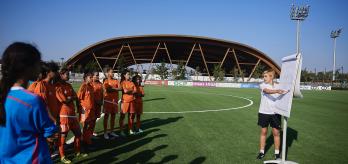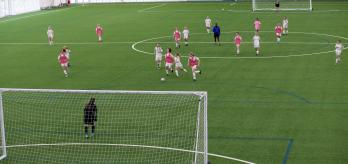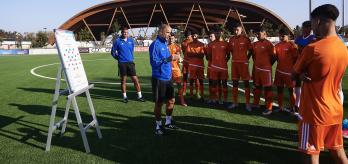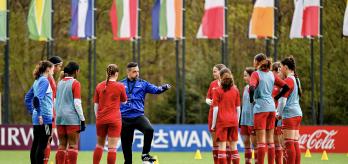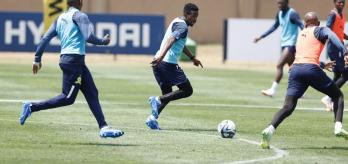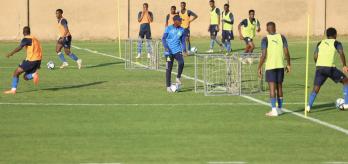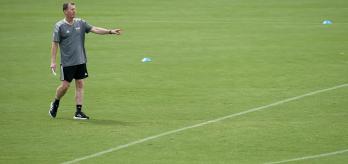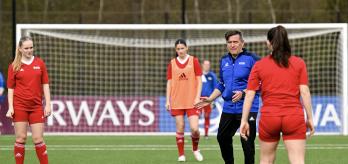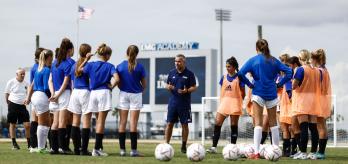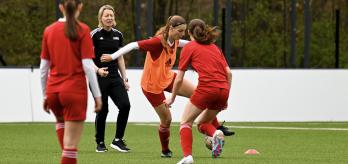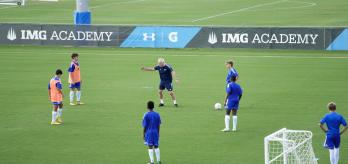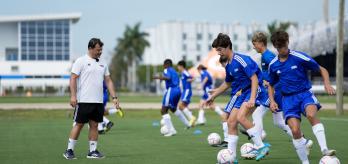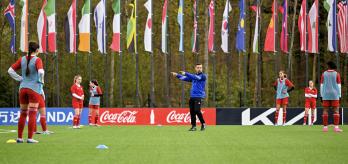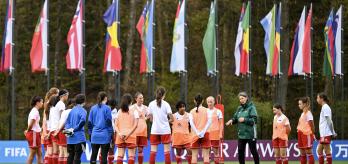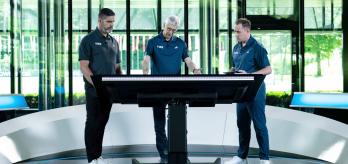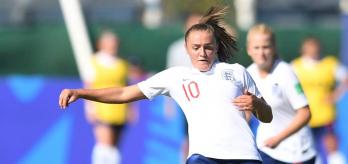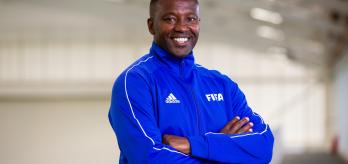Adopting a positive mindset and demanding the ball can be vital, providing a strong foundation when asked to build from the back. Moreover, to be better equipped to evade the opposition’s press and advance into attacking areas with purpose, players also need to be able to make quick decisions on the ball – based on the opposition’s actions – and to understand their role within the team’s set-up.
In this session, Tottenham Hotspur Women’s head coach, Rehanne Skinner, shares a range of drills that help players to build from the back efficiently when faced with various challenges. The focus of the session involves working on the key fundamentals, whilst gradually increasing the pitch size. Players initially work on progressing the ball through the central corridor on a small pitch, before the pitch size is increased to cater for a 10v10 game in which the full-backs play a more prominent role. The next drill involves an 11v9 game, which is played on a pitch that is larger than the one used in the previous exercises. Finally, all of these learnt elements are brought together onto a full-size pitch, where the players contest an 11v11 game.
Session overview
This session generally involves 22 players; however, some players may be rested in parts 2 and 3 and consideration should be given to rotating players throughout. In Part 1, players can be split into two groups that perform the same exercise.
- Part 1: playing through the thirds in tight spaces
- Part 2: 10v10 including goalkeepers: overloading the wide areas
- Part 3: 11v9 including goalkeepers: pressing and playing through the press
- Part 4: 11v11: building from the back
Key coaching points
- To move the ball effectively through the thirds, players need to adopt a positive and brave mindset, including being willing to get on the ball.
- Full-backs are a vital tool when it comes to building from the back and should be given licence to stay wide and provide passing options.
- When a team-mate is in possession, players should always be aware of the space around them and their angle of support. This enables them to receive the ball, open their body up and find space more easily.
- Encourage players to come and show for the ball. All players need to demand the ball in order to enable effective build-up, whilst midfielders are tasked with seeking pockets of space.
- Pass and receipt characteristics are an important consideration for players, who need to decide whether the pass should be played to the receiver’s front or back foot.
- Ideally, the pass should allow the receiver to break the defensive line with their first touch.
This training session was designed with specific game scenarios in mind and seeks to tackle the following question: when building from the back, how can players recognise and create space to play and receive passes that will allow them to progress the ball successfully into attacking areas? The objective is to offer players the solutions and skills to adapt to the opposition’s behaviour in terms of the nature of the press that they apply.
Part 1: Playing through the thirds in tight spaces
This exercise aims to offer players the skills and solutions to play when they are working the ball through the thirds, especially when the central areas are congested or there is little space in which to operate. Illustrating a number of different ways to play out under pressure can encourage players to be braver on the ball, set a positive tone, receive with a view to playing forwards and make quicker decisions when space is at a premium.
-
Mark out a 30x15m pitch.
-
Split the pitch into thirds.
-
Use 9 outfield players (7 attackers and 2 defenders), with a goalkeeper stationed at each end of the pitch.
-
Place 2 attackers in each of the end zones.
-
Place 3 attackers and 2 defenders in the middle third.
-
Place 2 mannequins in the middle third.
-
The aim is to work the ball from one end zone to the other via the middle third.
-
The 3 attacking players in the middle third are tasked with receiving the ball and progressing it into the end zone.
-
Players are allowed to take as many touches as they want in each third.
-
The ball has to reach each goalkeeper before it can be played back in the other direction.
-
The 2 defenders seek to prevent the ball from passing through the middle third.
-
The 2 defenders and 2 attackers should be rotated frequently.
-
Allow the 2 defenders to leave the middle third and press the opposition players situated in the end zones.
-
Bear in mind that the thirds respectively represent the defensive line, midfield line and forward line. In other words, passes in the first third represent passes made among the defensive line, passes inside the middle third represent the midfield line and passes into the final third represent passes made into the forward line.
-
Encourage players to be positive on the ball and play forwards at every opportunity.
-
The focus should be on playing passes to the foot that put the receiver in a position to break the defensive line.
-
Where the 2 defenders are narrow and sit close together, the attackers should look to play a wide pass in order to progress through the thirds.
-
Conversely, stretching the 2 defenders allows the central attacking player, who is situated in the middle third, to find space to receive a pass and progress the ball.
-
Emphasise the importance of the central attacking player resisting the temptation to drop deep and leave the middle third. Highlight that dropping deep would make things more straightforward for the defending team, as it would produce a 2v2 situation, making it easier for the defending team making it easier for the defending team to mark and prevent the ball from progressing through the centre.
-
Once the 2 defenders are allowed out of the middle third, the attacking team needs to pay greater attention to their movement and up the tempo so as to avoid losing possession.
Part 2: 10v10 including goalkeepers: overloading the wide areas
This exercise focuses on the choices available to a team when building from the back and how to make the most of them. When building from the back, a team can choose to play into the first line or the second line, depending on the opposition’s behaviour and positioning. Using the full-backs and attacking down the wide channels offers the attacking team a greater range of options. It also allows the team to create overloads to progress the ball and open up spaces to attack on the inside of the opposition’s defence.
-
Mark out a 50x40m pitch.
-
Split the pitch into thirds.
-
Split the middle third into 3 by creating a wide channel down each flank.
-
Make the wide channels 10m wide.
-
Set both teams up in a 4-3-2 formation (plus a goalkeeper).
-
Each team seeks to score by focusing on using the wide areas in the build-up.
-
For the team in possession, only the full-backs are allowed to enter the wide channels.
-
All players from the defending team are allowed to enter the wide channels and close the full-backs down.
-
The centre-backs are allowed to carry the ball into the central area if they have the time and space to do so.
-
Only 4 players from each team are allowed to occupy either end zone at any given time.
Variation 1
-
1 or 2 attackers can drop into the central area to receive the ball or create movement.
-
The defending team’s centre-backs are not allowed to follow the attackers into the central area and must stay in their end zone.
Variation 2
-
No more than 2 players per team are allowed in the central area.
-
The team in possession focuses on overloading the wide channels.
-
Focus on the full-backs’ decision-making. When attacking the wide channels, the decisions made by the full-backs should be based on the defending team’s behaviour and positioning.
-
Where the defending full-back closes down the full-back in possession, the spaces that appear will be different to those that are created when the attacking full-back is closed down by an opposing midfielder.
-
The attacking team should make quick decisions about where to progress the ball on the basis of the available spaces.
-
Players in possession need to be aware of their passing options and whether they are able to play the ball into a team-mate’s path.
-
The full-backs should concentrate on taking a good first touch that allows them to see the full picture and assess all available options.
-
When only 2 players per team are allowed in the central area, the focus should be on overloading the wide channels and isolating the opposition’s full-backs.
-
Encourage players to recognise overloading opportunities
Part 3: 11v9 including goalkeepers: pressing and playing through the press
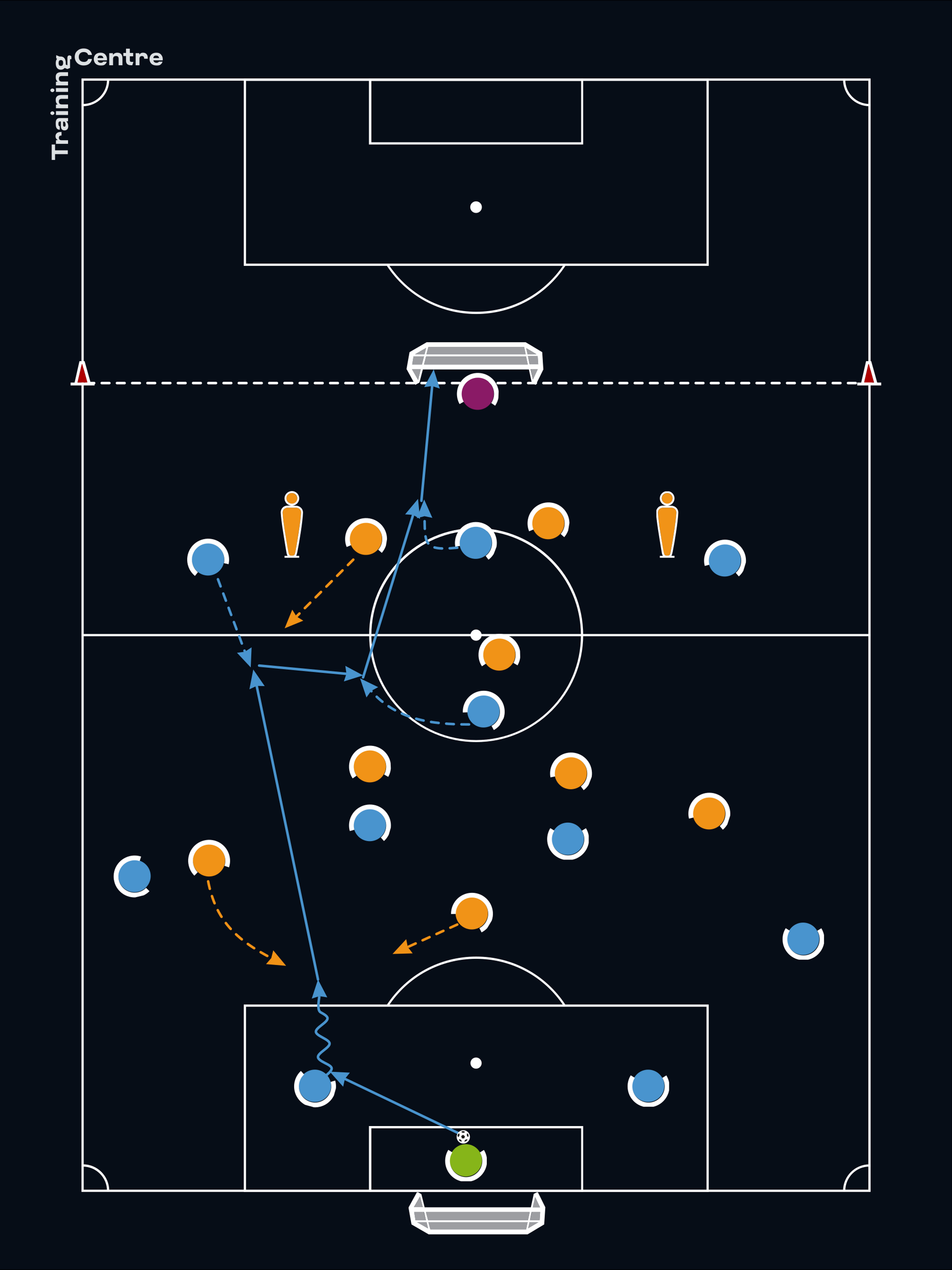
When building from the back, it is important to have good, purposeful possession and play with a sense of direction. Depending on the nature of the opposition’s press, the players on the team in possession need to work together to seek spaces and passing movements that will allow them to progress into attacking areas. Meanwhile, this exercise offers the defending team a number of pressing solutions that aim to force the side in possession into a mistake.
-
Mark out a 75x50m pitch (¾ of a full-size pitch).
-
The team with 11 players sets up in a 4-3-3 formation (plus a goalkeeper).
-
The team with 9 players sets up in a 2-3-3 formation (plus a goalkeeper).
-
The team with 9 players uses 2 mannequins instead of full-backs.
-
Play always starts with the goalkeeper on the team with 11 players.
-
The full-backs from both teams should begin the drill on the back shoulder of the midfield line.
-
The wingers need to stay high and play on the outside of the full-backs/ mannequins.
-
The centre-forwards need to stay high and influence the centre-backs as much as possible.
-
The wingers focus on pressing the centre-backs and forcing them to come inside.
-
This makes the opposition pass into central areas, which involves a higher level of risk.
-
When in possession, players need to constantly be thinking about how they can recognise and subsequently exploit spaces in which to receive or attack.
-
Whenever possible, the centre-backs need to carry the ball and step into the midfield line so as to draw the opposition out.
-
If the opposition shuts off the passing lane from the centre-back to the winger/attacking midfielder, the centre-back should look to play the ball to the full-back, who is positioned out wide, and vice versa.
-
The full-backs need to be aware of the opposition’s press and look to make themselves available in wide areas before getting in behind the defence, whilst the attacking midfielders/wingers need to drop deep to receive the ball.
-
If the goalkeepers find themselves under intense pressure, they can look to bypass the first line and clip the ball into midfield or the wingers.
Part 4: 11v11 building from the back
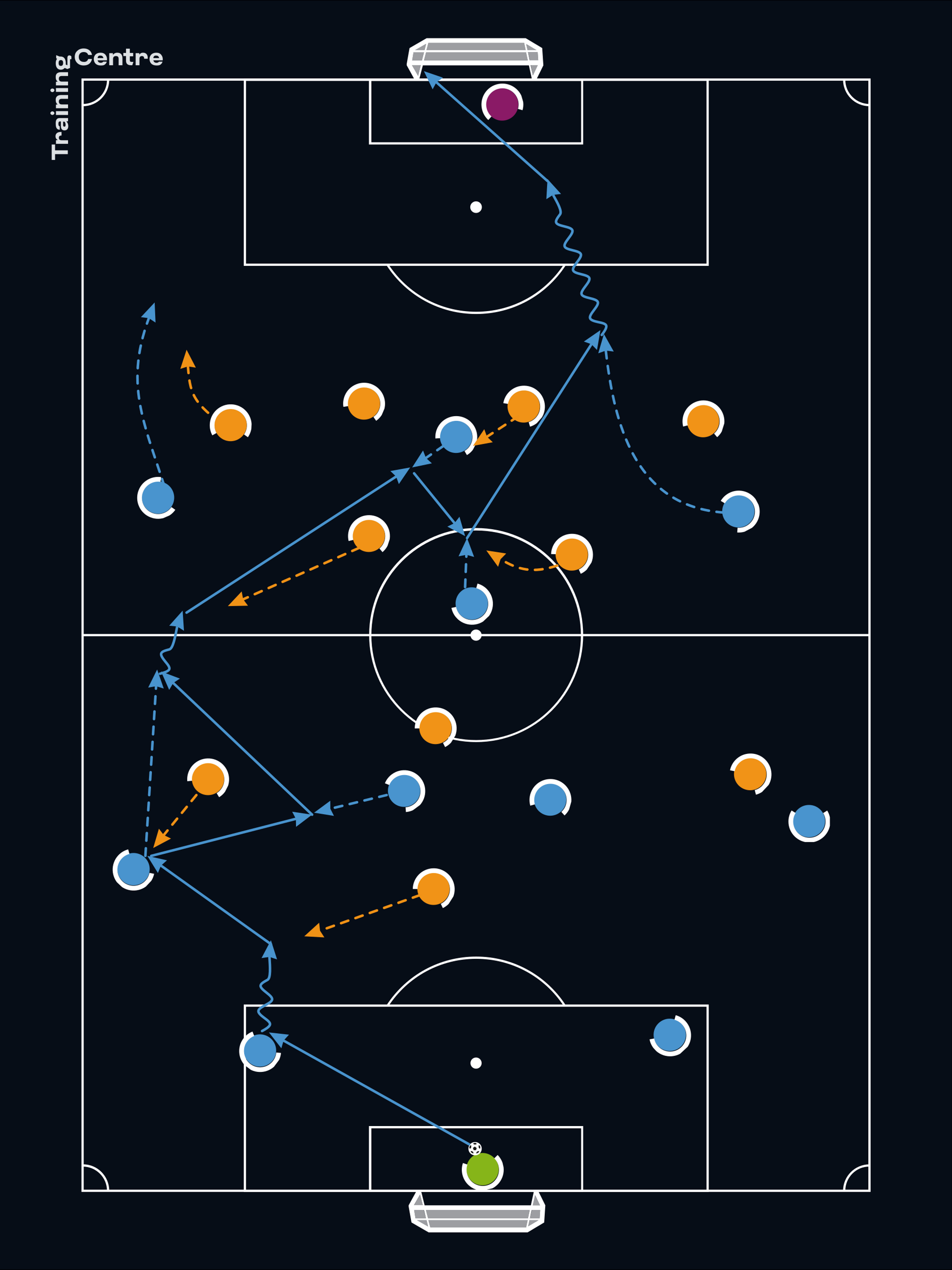
The session is rounded off with a drill that aims to bring together all of the previously covered elements with a view to building up play effectively on a full-size pitch. Players should now be capable of building from the back by using intelligent movement and passing into their targets’ paths, which will allow the team to progress the ball in a constructive manner with the objective of opening up spaces all over the pitch.
-
Use a full-size pitch.
-
Set 1 team up in a 4-3-3 formation (plus a goalkeeper).
-
Set the opposing team up in a 4-2-3-1 formation (plus a goalkeeper).
-
Contest a standard 11v11 game in which the teams adopt the above-mentioned formations.
-
If a team scores, they are rewarded by restarting play with the ball.
-
Allow the players to play freely for 2 minutes before providing feedback.
-
The central midfielders need to make intelligent runs in order to find space, whilst also playing precise passes into the path of their intended target.
-
The central midfielders should act as anchor points during the build-up and can carry the ball up the pitch.
-
When a team-mate is in possession, players need to consider their angle of support and whether they can receive the ball in a position that allows them to open their body up to play a progressive pass.
-
If the centre of the pitch is congested, midfielders can drop the ball back into defence, giving the full-backs the opportunity to pull out wide and into space to receive the ball.
-
Spatial awareness is a fundamental skill: players need to be mindful of what is going on around them at all times in order to progress the ball and offer their team-mates options.
-
When in transition or the opposition is not properly set up, the goalkeepers should look to get the ball quickly into the attacking players.
















